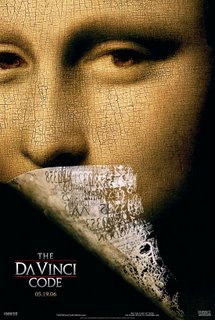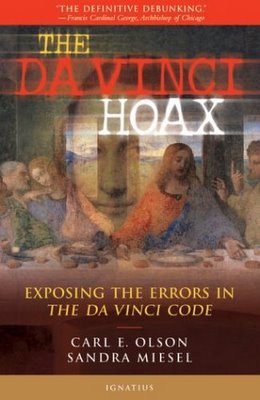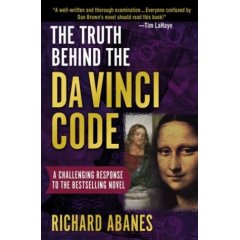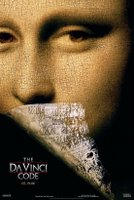Christian History - The Da Vinci Code Special Section
This article in Christianity Today recommended.
Saturday, February 11, 2006
Council of Nicea Summary
From Christianity Today
The central claim Brown's novel makes about Christianity is that "almost everything our fathers taught us about Christ is false." Why? Because of a single meeting of bishops in 325, at the city of Nicea in modern-day Turkey. There, argues Brown, church leaders who wanted to consolidate their power base (he calls this, anachronistically, "the Vatican" or "the Roman Catholic church") created a divine Christ and an infallible Scripture—both of them novelties that had never before existed among Christians.
Watershed at Nicea
Brown is right about one thing (and not much more). In the course of Christian history, few events loom larger than the Council of Nicea in 325. When the newly converted Roman Emperor Constantine called bishops from around the world to present-day Turkey, the church had reached a theological crossroads.
Led by an Alexandrian theologian named Arius, one school of thought argued that Jesus had undoubtedly been a remarkable leader, but he was not God in flesh. Arius proved an expert logician and master of extracting biblical proof texts that seemingly illustrated differences between Jesus and God, such as John 14:28: "the Father is greater than I." In essence, Arius argued that Jesus of Nazareth could not possibly share God the Father's unique divinity.
In The Da Vinci Code, Brown apparently adopts Arius as his representative for all pre-Nicene Christianity. Referring to the Council of Nicea, Brown claims that "until that moment in history, Jesus was viewed by His followers as a mortal prophet … a great and powerful man, but a man nonetheless."
In reality, early Christians overwhelmingly worshipped Jesus Christ as their risen Savior and Lord. Before the church adopted comprehensive doctrinal creeds, early Christian leaders developed a set of instructional summaries of belief, termed the "Rule" or "Canon" of Faith, which affirmed this truth. To take one example, the canon of prominent second-century bishop Irenaeus took its cue from 1 Corinthians 8:6: "Yet for us there is but one God, the Father, from whom all things came and for whom we live; and there is but one Lord, Jesus Christ."
The term used here—Lord, Kyrios—deserves a bit more attention. Kyrios was used by the Greeks to denote divinity (though sometimes also, it is true, as a simple honorific). In the Greek translation of the Old Testament (the Septuagint, pre-dating Christ), this term became the preferred substitution for "Jahweh," the holy name of God. The Romans also used it to denote the divinity of their emperor, and the first-century Jewish writer Josephus tells us that the Jews refused to use it of the emperor for precisely this reason: only God himself was kyrios.
The Christians took over this usage of kyrios and applied it to Jesus, from the earliest days of the church. They did so not only in Scripture itself (which Brown argues was doctored after Nicea), but in the earliest extra-canonical Christian book, the Didache, which scholars agree was written no later than the late 100s. In this book, the earliest Aramaic-speaking Christians refer to Jesus as Lord.
In addition, pre-Nicene Christians acknowledged Jesus's divinity by petitioning God the Father in Christ's name. Church leaders, including Justin Martyr, a second-century luminary and the first great church apologist, baptized in the name of the triune God—Father, Son, and Holy Spirit—thereby acknowledging the equality of the one Lord's three distinct persons.
The Council of Nicea did not entirely end the controversy over Arius's teachings, nor did the gathering impose a foreign doctrine of Christ's divinity on the church. The participating bishops merely affirmed the historic and standard Christian beliefs, erecting a united front against future efforts to dilute Christ's gift of salvation.
"Fax from Heaven"?
With the Bible playing a central role in Christianity, the question of Scripture's historic validity bears tremendous implications. Brown claims that Constantine commissioned and bankrolled a staff to manipulate existing texts and thereby divinize the human Christ.
Yet for a number of reasons, Brown's speculations fall flat. Brown correctly points out that "the Bible did not arrive by fax from heaven." Indeed, the Bible's composition and consolidation may appear a bit too human for the comfort of some Christians. But Brown overlooks the fact that the human process of canonization had progressed for centuries before Nicea, resulting in a nearly complete canon of Scripture before Nicea or even Constantine's legalization of Christianity in 313.
Ironically, the process of collecting and consolidating Scripture was launched when a rival sect produced its own quasi-biblical canon. Around 140 a Gnostic leader named Marcion began spreading a theory that the New and Old Testaments didn't share the same God. Marcion argued that the Old Testament's God represented law and wrath while the New Testament's God, represented by Christ, exemplified love. As a result Marcion rejected the Old Testament and the most overtly Jewish New Testament writings, including Matthew, Mark, Acts, and Hebrews. He manipulated other books to downplay their Jewish tendencies. Though in 144 the church in Rome declared his views heretical, Marcion's teaching sparked a new cult. Challenged by Marcion's threat, church leaders began to consider earnestly their own views on a definitive list of Scriptural books including both the Old and New Testaments.
Another rival theology nudged the church toward consolidating the New Testament. During the mid- to late-second century, a man from Asia Minor named Montanus boasted of receiving a revelation from God about an impending apocalypse. The four Gospels and Paul's epistles achieved wide circulation and largely unquestioned authority within the early church but hadn't yet been collected in a single authoritative book. Montanus saw in this fact an opportunity to spread his message, by claiming authoritative status for his new revelation. Church leaders met the challenge around 190 and circulated a definitive list of apostolic writings that is today called the Muratorian Canon, after its modern discoverer. The Muratorian Canon bears striking resemblance to today's New Testament but includes two books, Revelation of Peter and Wisdom of Solomon, which were later excluded from the canon.
By the time of Nicea, church leaders debated the legitimacy of only a few books that we accept today, chief among them Hebrews and Revelation, because their authorship remained in doubt. In fact, authorship was the most important consideration for those who worked to solidify the canon. Early church leaders considered letters and eyewitness accounts authoritative and binding only if they were written by an apostle or close disciple of an apostle. This way they could be assured of the documents' reliability. As pastors and preachers, they also observed which books did in fact build up the church—a good sign, they felt, that such books were inspired Scripture. The results speak for themselves: the books of today's Bible have allowed Christianity to spread, flourish, and endure worldwide.
Though unoriginal in its allegations, The Da Vinci Code proves that some misguided theories never entirely fade away. They just reappear periodically in a different disguise. Brown's claims resemble those of Arius and his numerous heirs throughout history, who have contradicted the united testimony of the apostles and the early church they built. Those witnesses have always attested that Jesus Christ was and remains God himself. It didn't take an ancient council to make this true. And the pseudohistorical claims of a modern novel can't make it false.
The central claim Brown's novel makes about Christianity is that "almost everything our fathers taught us about Christ is false." Why? Because of a single meeting of bishops in 325, at the city of Nicea in modern-day Turkey. There, argues Brown, church leaders who wanted to consolidate their power base (he calls this, anachronistically, "the Vatican" or "the Roman Catholic church") created a divine Christ and an infallible Scripture—both of them novelties that had never before existed among Christians.
Watershed at Nicea
Brown is right about one thing (and not much more). In the course of Christian history, few events loom larger than the Council of Nicea in 325. When the newly converted Roman Emperor Constantine called bishops from around the world to present-day Turkey, the church had reached a theological crossroads.
Led by an Alexandrian theologian named Arius, one school of thought argued that Jesus had undoubtedly been a remarkable leader, but he was not God in flesh. Arius proved an expert logician and master of extracting biblical proof texts that seemingly illustrated differences between Jesus and God, such as John 14:28: "the Father is greater than I." In essence, Arius argued that Jesus of Nazareth could not possibly share God the Father's unique divinity.
In The Da Vinci Code, Brown apparently adopts Arius as his representative for all pre-Nicene Christianity. Referring to the Council of Nicea, Brown claims that "until that moment in history, Jesus was viewed by His followers as a mortal prophet … a great and powerful man, but a man nonetheless."
In reality, early Christians overwhelmingly worshipped Jesus Christ as their risen Savior and Lord. Before the church adopted comprehensive doctrinal creeds, early Christian leaders developed a set of instructional summaries of belief, termed the "Rule" or "Canon" of Faith, which affirmed this truth. To take one example, the canon of prominent second-century bishop Irenaeus took its cue from 1 Corinthians 8:6: "Yet for us there is but one God, the Father, from whom all things came and for whom we live; and there is but one Lord, Jesus Christ."
The term used here—Lord, Kyrios—deserves a bit more attention. Kyrios was used by the Greeks to denote divinity (though sometimes also, it is true, as a simple honorific). In the Greek translation of the Old Testament (the Septuagint, pre-dating Christ), this term became the preferred substitution for "Jahweh," the holy name of God. The Romans also used it to denote the divinity of their emperor, and the first-century Jewish writer Josephus tells us that the Jews refused to use it of the emperor for precisely this reason: only God himself was kyrios.
The Christians took over this usage of kyrios and applied it to Jesus, from the earliest days of the church. They did so not only in Scripture itself (which Brown argues was doctored after Nicea), but in the earliest extra-canonical Christian book, the Didache, which scholars agree was written no later than the late 100s. In this book, the earliest Aramaic-speaking Christians refer to Jesus as Lord.
In addition, pre-Nicene Christians acknowledged Jesus's divinity by petitioning God the Father in Christ's name. Church leaders, including Justin Martyr, a second-century luminary and the first great church apologist, baptized in the name of the triune God—Father, Son, and Holy Spirit—thereby acknowledging the equality of the one Lord's three distinct persons.
The Council of Nicea did not entirely end the controversy over Arius's teachings, nor did the gathering impose a foreign doctrine of Christ's divinity on the church. The participating bishops merely affirmed the historic and standard Christian beliefs, erecting a united front against future efforts to dilute Christ's gift of salvation.
"Fax from Heaven"?
With the Bible playing a central role in Christianity, the question of Scripture's historic validity bears tremendous implications. Brown claims that Constantine commissioned and bankrolled a staff to manipulate existing texts and thereby divinize the human Christ.
Yet for a number of reasons, Brown's speculations fall flat. Brown correctly points out that "the Bible did not arrive by fax from heaven." Indeed, the Bible's composition and consolidation may appear a bit too human for the comfort of some Christians. But Brown overlooks the fact that the human process of canonization had progressed for centuries before Nicea, resulting in a nearly complete canon of Scripture before Nicea or even Constantine's legalization of Christianity in 313.
Ironically, the process of collecting and consolidating Scripture was launched when a rival sect produced its own quasi-biblical canon. Around 140 a Gnostic leader named Marcion began spreading a theory that the New and Old Testaments didn't share the same God. Marcion argued that the Old Testament's God represented law and wrath while the New Testament's God, represented by Christ, exemplified love. As a result Marcion rejected the Old Testament and the most overtly Jewish New Testament writings, including Matthew, Mark, Acts, and Hebrews. He manipulated other books to downplay their Jewish tendencies. Though in 144 the church in Rome declared his views heretical, Marcion's teaching sparked a new cult. Challenged by Marcion's threat, church leaders began to consider earnestly their own views on a definitive list of Scriptural books including both the Old and New Testaments.
Another rival theology nudged the church toward consolidating the New Testament. During the mid- to late-second century, a man from Asia Minor named Montanus boasted of receiving a revelation from God about an impending apocalypse. The four Gospels and Paul's epistles achieved wide circulation and largely unquestioned authority within the early church but hadn't yet been collected in a single authoritative book. Montanus saw in this fact an opportunity to spread his message, by claiming authoritative status for his new revelation. Church leaders met the challenge around 190 and circulated a definitive list of apostolic writings that is today called the Muratorian Canon, after its modern discoverer. The Muratorian Canon bears striking resemblance to today's New Testament but includes two books, Revelation of Peter and Wisdom of Solomon, which were later excluded from the canon.
By the time of Nicea, church leaders debated the legitimacy of only a few books that we accept today, chief among them Hebrews and Revelation, because their authorship remained in doubt. In fact, authorship was the most important consideration for those who worked to solidify the canon. Early church leaders considered letters and eyewitness accounts authoritative and binding only if they were written by an apostle or close disciple of an apostle. This way they could be assured of the documents' reliability. As pastors and preachers, they also observed which books did in fact build up the church—a good sign, they felt, that such books were inspired Scripture. The results speak for themselves: the books of today's Bible have allowed Christianity to spread, flourish, and endure worldwide.
Though unoriginal in its allegations, The Da Vinci Code proves that some misguided theories never entirely fade away. They just reappear periodically in a different disguise. Brown's claims resemble those of Arius and his numerous heirs throughout history, who have contradicted the united testimony of the apostles and the early church they built. Those witnesses have always attested that Jesus Christ was and remains God himself. It didn't take an ancient council to make this true. And the pseudohistorical claims of a modern novel can't make it false.
The Council of Nicea
The Council of Nicea took place in 325 A.D. by the order of the Roman Emperor Caesar Flavius Constantine. Nicea was located in Asia Minor, east of Constantinople. At the Council of Nicea, Emperor Constantine presided over a group of Church bishops and leaders with the purpose of defining the true God for all of Christianity and to eliminate all the confusion, controversy, and contention within Christ’s church. The Council of Nicea affirmed the deity of Jesus Christ and established an official definition of the Trinity - the deity of The Father, Son, and Holy Spirit under one Godhead, having three co-equal and co-eternal Persona.
Constantine, a converted Christian (debatably), called for a council meeting to be held in Nicea with the bishop’s of the Christian church to resolve escalating quarrels and controversy mounting to a bitter degree of disunity among the church leadership and congregates concerning theological issues. The failing Roman Empire, now under Constantine’s rule, could not withstand the division caused by years of hard fought, “out of hand” arguing over doctrinal differences. He saw it not only as a threat to Christianity but as a threat to society as well. Therefore, at the Council of Nicea, Constantine asked that the Christians settle their internal disagreements and become Christ-like agents who could bring new life into a troubled, beaten down empire. Constantine felt “called” to use his authority to help bring about the unity, peace, and love, all for which Christ stands. He and the bishops had reason to worry about the future survival of Christianity within the Roman world empire, let alone the survival of his world empire as well. The Council of Nicea, was the meeting to settle differences, to become like minded, all to the glory of Christ.
The main theological issue and focus had always been about Christ. Since the ending of the Apostolic Age and beginning of the Church Age saints began questioning, debating, fighting, and separating over, “Who is the Christ?” Is He more “divine than human” or more “human than divine?” Was Jesus created / made or begotten? Being the Son of God, is He co-equal and co-eternal with Father God or less and lower in status than? Is the Father the One and only True God or is the Father, the Son, and the Holy Spirit the One true God? “True God of True God”, “One Being, Three Persons”, a tri-unity called “Trinity”? Jesus said, “Who do you say that I am?” (Matthew 16:15).
Constantine requested that the 300 bishops make a decision by majority vote defining who Jesus Christ is. The Council produced a doctrine that all of Christianity would follow and obey, a doctrine that would be called the “Nicene Creed” upheld by the Church and enforced by the Emperor. The bishops voted to make the full deity of Christ the accepted position for the church. The Council of Nicea voted to make the Trinity the official doctrine of the church. However, the Council of Nicea did not invent these doctrines. Rather, it only recognized what the Bible taught, and systematized the doctrines.
The New Testament taught that Jesus the Messiah, should be worshipped and trusted which was/is to say He is co-equally God and man. The New Testament forbids the worship of angles (Colossians 2.18; Revelation 22.8,9) but commands worship of Jesus. Apostle Paul says about Jesus that, “in him the fullness of Deity dwells bodily” (Colossians 2.9; cf. 1.19). Paul declares Jesus as Lord and the One to whom a person must pray for salvation just as one calls on Jehovah, Yahweh (Joel 2.32; Romans 10.9-13). “Jesus is God overall” (Romans 9.5). Our God and Savior (Titus 2.13). Faith in Jesus’ Deity is basic to Paul’s testimony and theology.
Apostle John’s Gospel declares Jesus being the Devine eternal Logo’s, agent of creation and source of life and light (John 1. 1-5, 9). That Jesus is “the Way, the Truth, and the Life (John 14.6), an advocate with heavenly Father (1 John 2.1-2), that He is sovereign (Revelation 1.5), the Rider on white horse (Revelation 19.11-16), and the totality of the Son of God from the beginning to the end (Revelation 22.13). The author of Hebrews reveals the full deity of Jesus thru His perfection as the most high priest, Melchizedek (Hebrews 1.1,3,6,8,-12;7.3), and the full humanity (Hebrews chapter 2). The Divine-human Savior being the Christians object of faith, hope, and love.
The Council of Nicea did not invent the doctrine of the deity of Christ. Rather, the Council of Nicea affirmed the Apostles teaching of who Christ is as the One true God in Deity and Trinity with the Father and the Holy Spirit.
Constantine, a converted Christian (debatably), called for a council meeting to be held in Nicea with the bishop’s of the Christian church to resolve escalating quarrels and controversy mounting to a bitter degree of disunity among the church leadership and congregates concerning theological issues. The failing Roman Empire, now under Constantine’s rule, could not withstand the division caused by years of hard fought, “out of hand” arguing over doctrinal differences. He saw it not only as a threat to Christianity but as a threat to society as well. Therefore, at the Council of Nicea, Constantine asked that the Christians settle their internal disagreements and become Christ-like agents who could bring new life into a troubled, beaten down empire. Constantine felt “called” to use his authority to help bring about the unity, peace, and love, all for which Christ stands. He and the bishops had reason to worry about the future survival of Christianity within the Roman world empire, let alone the survival of his world empire as well. The Council of Nicea, was the meeting to settle differences, to become like minded, all to the glory of Christ.
The main theological issue and focus had always been about Christ. Since the ending of the Apostolic Age and beginning of the Church Age saints began questioning, debating, fighting, and separating over, “Who is the Christ?” Is He more “divine than human” or more “human than divine?” Was Jesus created / made or begotten? Being the Son of God, is He co-equal and co-eternal with Father God or less and lower in status than? Is the Father the One and only True God or is the Father, the Son, and the Holy Spirit the One true God? “True God of True God”, “One Being, Three Persons”, a tri-unity called “Trinity”? Jesus said, “Who do you say that I am?” (Matthew 16:15).
Constantine requested that the 300 bishops make a decision by majority vote defining who Jesus Christ is. The Council produced a doctrine that all of Christianity would follow and obey, a doctrine that would be called the “Nicene Creed” upheld by the Church and enforced by the Emperor. The bishops voted to make the full deity of Christ the accepted position for the church. The Council of Nicea voted to make the Trinity the official doctrine of the church. However, the Council of Nicea did not invent these doctrines. Rather, it only recognized what the Bible taught, and systematized the doctrines.
The New Testament taught that Jesus the Messiah, should be worshipped and trusted which was/is to say He is co-equally God and man. The New Testament forbids the worship of angles (Colossians 2.18; Revelation 22.8,9) but commands worship of Jesus. Apostle Paul says about Jesus that, “in him the fullness of Deity dwells bodily” (Colossians 2.9; cf. 1.19). Paul declares Jesus as Lord and the One to whom a person must pray for salvation just as one calls on Jehovah, Yahweh (Joel 2.32; Romans 10.9-13). “Jesus is God overall” (Romans 9.5). Our God and Savior (Titus 2.13). Faith in Jesus’ Deity is basic to Paul’s testimony and theology.
Apostle John’s Gospel declares Jesus being the Devine eternal Logo’s, agent of creation and source of life and light (John 1. 1-5, 9). That Jesus is “the Way, the Truth, and the Life (John 14.6), an advocate with heavenly Father (1 John 2.1-2), that He is sovereign (Revelation 1.5), the Rider on white horse (Revelation 19.11-16), and the totality of the Son of God from the beginning to the end (Revelation 22.13). The author of Hebrews reveals the full deity of Jesus thru His perfection as the most high priest, Melchizedek (Hebrews 1.1,3,6,8,-12;7.3), and the full humanity (Hebrews chapter 2). The Divine-human Savior being the Christians object of faith, hope, and love.
The Council of Nicea did not invent the doctrine of the deity of Christ. Rather, the Council of Nicea affirmed the Apostles teaching of who Christ is as the One true God in Deity and Trinity with the Father and the Holy Spirit.
Sunday a Pagan Holiday?
Da Vinci Code, pages 232-233: "Christianity's weekly holy day was stolen from the pagans. Christianity honored the Jewish Sabbath of Saturday, but Constantine shifted it to coincide with the pagan's veneration day of the sun."
Actually, long before Constantine was even born, there were Christian writings that made it clear that there was a Sabbath, which corresponds to Saturday, and a "Lord's Day," which corresponds to Sunday. Since the early beginnings of Christianity, Christians had an affection for the first day of the week (Sunday) because this is the day on which Jesus was resurrected. Early references to the "Lord's Day" include Acts 20:7 and 1 Corinthians 16:2, which are books in the New Testament. These were written during the first century and predate the birth of Constantine by more than 200 years! Outside of the New Testament, there are early Christian writings that confirm that Christians celebrated a "Lord's Day" (Sunday). These writings include those by Justin Martyr and Melito of Sardis. Both lived during the Second Century (during the 100s), and both had already died before Constantine was even born.
Actually, long before Constantine was even born, there were Christian writings that made it clear that there was a Sabbath, which corresponds to Saturday, and a "Lord's Day," which corresponds to Sunday. Since the early beginnings of Christianity, Christians had an affection for the first day of the week (Sunday) because this is the day on which Jesus was resurrected. Early references to the "Lord's Day" include Acts 20:7 and 1 Corinthians 16:2, which are books in the New Testament. These were written during the first century and predate the birth of Constantine by more than 200 years! Outside of the New Testament, there are early Christian writings that confirm that Christians celebrated a "Lord's Day" (Sunday). These writings include those by Justin Martyr and Melito of Sardis. Both lived during the Second Century (during the 100s), and both had already died before Constantine was even born.
On Downgrading Mary and Women
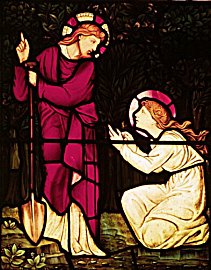
These claims are very important to Dan Brown's storyline. The historical evidence, however, strongly contradicts Brown's claim. Mary Magdalene is held in special regard by the Catholic Church, in part because she was the first person to witness the resurrection of Jesus Christ. If the Catholic Church wanted to tarnish the image of Mary Magdalene, and if it was willing to rewrite scripture to do it, then why would it allow Mary Magdalene to be the first person to have witnessed the most important event in all of Christianity, which is the resurrection?
Another problem for Brown's theory is that the Vatican exalts Mary Magdalene – as a saint! In fact, several churches are named in honor of Mary Magdalene, who is also honored with an annual celebration by Catholics.
And if someone can still think that Brown's theory is somehow true, that the Vatican allegedly hates women, then consider its regard for another woman named Mary – the mother of Jesus. And when you're finished contemplating that, apologize to yourself if you even momentarily thought that Dan Brown was on to something.
Smearing the Pentacle
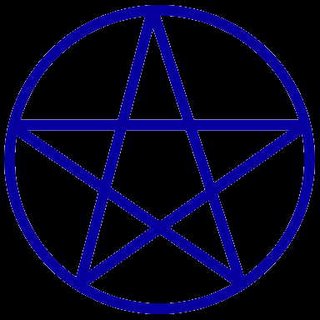
As for Brown's claim about the pentacle, even that contradicts historical evidence. The fact is, many Christians actually embraced the pentacle! "The truth is, during the later medieval era (the 1100s to the 1500s), Christians used the pentagram and pentacle as a reminder of Christ's five wounds (hands, feet, side, back, head). They also used it as a symbol for "the five books of Moses" and "the five stones used by David against Goliath," according to page 32 of The Truth Behind the Da Vinci Code.
There is nothing about a symbol, such as the pentacle or pentagram, that is inherently good or evil. Its meaning depends on who is using it and for what purpose they are using it. Some school teachers will mark a student's homework assignment with a star (a pentacle) to show that the student did excellent work. In this context, there is nothing demonic about the pentacle, it simply represents "stellar" work. But, when the founder of the Church of Satan needed a symbol for his religion during the 1960s he chose to use a pentacle, which he turned upside down. A pentacle, then, is what one makes of it.
So who "demonized" the pentacle? According to some scholars, and according to some modern pagan sources, it was a French occultist who lived during the 1800s. In other words, it was a pagan who "demonized" the symbol.
On Demonizing Paganism
The Da Vinci Code, page 37: "As part of the Vatican's campaign to eradicate pagan religions and convert the masses to Christianity, the church launched a smear campaign against the pagan gods and goddesses, recasting their divine symbols as evil.... Venus' pentacle became the sign of the devil."
Many people might not realize this, but there is a great deal of historical evidence that shows that pagans tried to eradicate Christianity and that pagans copied Christian symbols and ceremonies in the hopes of surviving the rapid spread of Christianity, especially during the first three centuries after the time of Jesus. During that era, the pagans had tremendous resources, including the support of emperors, who by default, where designated as high priests of pagan religions. Their efforts to eradicate Christianity were remarkably unsuccessful, and Christianity was able to become the first religion to spread to followers worldwide. Even today, it can be argued that Christianity is still the only worldwide religion.
As for Brown's claim about the pentacle, even that contradicts historical evidence. The fact is, many Christians actually embraced the pentacle! "The truth is, during the later medieval era (the 1100s to the 1500s), Christians used the pentagram and pentacle as a reminder of Christ's five wounds (hands, feet, side, back, head). They also used it as a symbol for "the five books of Moses" and "the five stones used by David against Goliath," according to page 32 of The Truth Behind the Da Vinci Code.
There is nothing about a symbol, such as the pentacle or pentagram, that is inherently good or evil. Its meaning depends on who is using it and for what purpose they are using it. Some school teachers will mark a student's homework assignment with a star (a pentacle) to show that the student did excellent work. In this context, there is nothing demonic about the pentacle, it simply represents "stellar" work. But, when the founder of the Church of Satan needed a symbol for his religion during the 1960s he chose to use a pentacle, which he turned upside down. A pentacle, then, is what one makes of it.
So who "demonized" the pentacle? According to some scholars, and according to some modern pagan sources, it was a French occultist who lived during the 1800s. In other words, it was a pagan who "demonized" the symbol.
Many people might not realize this, but there is a great deal of historical evidence that shows that pagans tried to eradicate Christianity and that pagans copied Christian symbols and ceremonies in the hopes of surviving the rapid spread of Christianity, especially during the first three centuries after the time of Jesus. During that era, the pagans had tremendous resources, including the support of emperors, who by default, where designated as high priests of pagan religions. Their efforts to eradicate Christianity were remarkably unsuccessful, and Christianity was able to become the first religion to spread to followers worldwide. Even today, it can be argued that Christianity is still the only worldwide religion.
As for Brown's claim about the pentacle, even that contradicts historical evidence. The fact is, many Christians actually embraced the pentacle! "The truth is, during the later medieval era (the 1100s to the 1500s), Christians used the pentagram and pentacle as a reminder of Christ's five wounds (hands, feet, side, back, head). They also used it as a symbol for "the five books of Moses" and "the five stones used by David against Goliath," according to page 32 of The Truth Behind the Da Vinci Code.
There is nothing about a symbol, such as the pentacle or pentagram, that is inherently good or evil. Its meaning depends on who is using it and for what purpose they are using it. Some school teachers will mark a student's homework assignment with a star (a pentacle) to show that the student did excellent work. In this context, there is nothing demonic about the pentacle, it simply represents "stellar" work. But, when the founder of the Church of Satan needed a symbol for his religion during the 1960s he chose to use a pentacle, which he turned upside down. A pentacle, then, is what one makes of it.
So who "demonized" the pentacle? According to some scholars, and according to some modern pagan sources, it was a French occultist who lived during the 1800s. In other words, it was a pagan who "demonized" the symbol.
False: Constantine Shaped Scripture
This is essential to the plot in The Da Vinci Code because it requires that the reader can believe that Constantine replaced the Gnostic writings with what we now call the New Testament. But, Constantine could not have had a hand in shaping the New Testament for two reasons: He wasn't born soon enough and he didn't live long enough. Based on writings from early church leaders, which date from the year 96 through the year 112, 24 of the 27 books that are part of today's New Testament were already regarded by early Christians as being authoritative, a full 213 years before Constantine convened the Council of Nicea. And, the Council of Nicea didn't canonize anything. The canonization process occurred a full 70 years later, on a different continent. In addition, there were several writings by early church leaders, who died long before Constantine was even born, that collectively quote thousands of New Testament passages
Witch Hunts
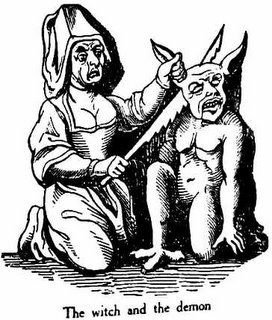
Fiction: The Vatican killed an "astounding 5 million women" during the witch hunts
This is important to Dan Brown's The Da Vinci Code, because in order for novel's storyline to work, the Catholic Church must be portrayed as an evil, oppressive institution that hates, oppresses and feels threatened by women.
But, despite Brown's claims that there were 5 million women burned to death by the Vatican, the fact is many scholars, including those who are not Christian, say that the witch hunts were generally done by local governments and individuals. Many scholarly sources estimate that the number of people killed by the witch hunts is between 20,000 to 100,000. And, some sources estimate that 20 to 25 percent of the victims were men.
Here are some additional details from page 36 of The Truth Behind the Da Vinci Code:
It also should be noted that these persecutions were actually "a collaborative enterprise between men and women at the local level." Adam Jones, professor of international studies at the Center for Research and Teaching Economics (Mexico City), has cited many sources showing that most of the accusations of witchcraft "originated in 'conflicts [that] normally opposed one woman to another.'"
For instance, Jones quotes Robin Briggs (author of Witches & Neighbours: The Social and Cultural Context of European Witchcraft) as saying that "most informal accusations were made by women against other women." In Malevolent Nurture, Deborah Willis of the University of California, Riverside, confirms that "women were actively involved in making witchcraft accusations against their female neighbors." She adds, "To a considerable extent, then, village-level witch-hunting was women's work."
JEHOAVAH what?
The Da Vinci Code, on page 309, claims: "The Jewish Tetragrammaton YHWH - the sacred name of God - in fact derived from Jehovah, an androgynous physical union between the masculine Jah and the pre-Hebraic name for Eve, Havah"
This is perhaps one of the most embarrassing errors within Dan Brown's The Da Vinci Code. The word Jehovah isn't the name for God. In fact, that word doesn't appear in the Bible in either the Hebrew text of the Old Testament or in the Greek text of the New Testament. The word Jehovah is a made-up English word.
The ancient Jews began a tradition that they would not pronounce the name of God (YHWH), as a way of showing respect. Instead, when they read aloud from the Hebrew Scriptures (Old Testament), and they came across the name for God (YHWH), they would substitute another word – the Hebrew word for "Lord," which is "Adonah." This is similar to the practice of addressing a king as "Lord," rather than as "king."
Over time, the vowel sounds for the Hebrew word "Adonah" were fused with the consonants for the name of God (YHWH), and a new word was created - "Yehovah." (This hybrid word, which didn't exist until roughly 500 years ago, was often mistakenly pronounced by English speakers as "Jehovah," even though there is no J sound in the Hebrew language).
Therefore, any theory, however ill-intentioned or well-intentioned, that involves either the word "Jehovah" or the word "Yehovah" is completely meaningless, because there is no such word in the Hebrew text of the Old Testament or in the Greek text of the New Testament.
Brown, however, isn't the first person to mistakenly think that Jehovah was an actual word. And given the popularity of his novel, he won't be the last.
This is perhaps one of the most embarrassing errors within Dan Brown's The Da Vinci Code. The word Jehovah isn't the name for God. In fact, that word doesn't appear in the Bible in either the Hebrew text of the Old Testament or in the Greek text of the New Testament. The word Jehovah is a made-up English word.
The ancient Jews began a tradition that they would not pronounce the name of God (YHWH), as a way of showing respect. Instead, when they read aloud from the Hebrew Scriptures (Old Testament), and they came across the name for God (YHWH), they would substitute another word – the Hebrew word for "Lord," which is "Adonah." This is similar to the practice of addressing a king as "Lord," rather than as "king."
Over time, the vowel sounds for the Hebrew word "Adonah" were fused with the consonants for the name of God (YHWH), and a new word was created - "Yehovah." (This hybrid word, which didn't exist until roughly 500 years ago, was often mistakenly pronounced by English speakers as "Jehovah," even though there is no J sound in the Hebrew language).
Therefore, any theory, however ill-intentioned or well-intentioned, that involves either the word "Jehovah" or the word "Yehovah" is completely meaningless, because there is no such word in the Hebrew text of the Old Testament or in the Greek text of the New Testament.
Brown, however, isn't the first person to mistakenly think that Jehovah was an actual word. And given the popularity of his novel, he won't be the last.
Christianity Stole Ideas from Paganism?
The Da Vinci Code, on page 232: claims: "Nothing in Christianity is original. The pre-Christian god Mithras - called the Son of God and the Light of the World - was born on December 25, died, was buried in a rock tomb, and then resurrected in three days. By the way, December 25 was also the birthday of Osiris, Adonis, and Dionysus. The newborn Krishna was presented with gold, frankincense, and myrrh."
This sequence of claims has puzzled many critics of Brown's book as to their possible origin, if indeed they have an origin outside of the author's imagination.
Serious scholars who have studied the Mithraic traditions, including Franz Cumont, paint a very different portrayal. They don't mention any death of Mithra, and they certainly don't mention any type of resurrection for Mithra.
Some Christians do celebrate Christmas on December 25 as a time of year to commemorate the birth and life of Jesus. But that doesn't mean that they believe that Jesus was born on that particular date. In fact, the Bible does not mention a specific birth date for Jesus.
For comparison, consider the American holiday called "Presidents Day." The holiday occurs on a day in February, but that doesn't mean that Americans believe that all presidents were born on that particular day in February. Of course not. It is simply a day that is set aside to commemorate American presidents.
As for the claim that the myths known as Osiris, Adonis and Dionysus were born on December 25, I have been unable to track down any scholarly source that actually makes that claim.
In regards to some of the other claims involving Mithra and Christianity, consider the following from page 87 of de-coding Da Vinci: The facts behind the fiction of The Da Vinci Code by Amy Welborn:
"Mithras was a god with many forms. By the centuries after Christ, his cult was primarily a mystery religion, popular among men, especially soldiers. Mithraic studies do not find any attribution of the titles 'Son of God' or 'Light of the World,' as Brown claims. There is also no mention of a death-resurrection motif in Mithraic mythology. Brown seems to have picked this up from a discredited nineteenth-century historian, who provided no documentation for his assertion. The same historian is the source for the Krishna connection to which Brown alludes. There is not a single story in actual Hindu mythology of Krishna being presented with gold, frankincense, and myrrh at his birth (see Miesel and Olsen, Cracking the Anti-Catholic Code)."
This sequence of claims has puzzled many critics of Brown's book as to their possible origin, if indeed they have an origin outside of the author's imagination.
Serious scholars who have studied the Mithraic traditions, including Franz Cumont, paint a very different portrayal. They don't mention any death of Mithra, and they certainly don't mention any type of resurrection for Mithra.
Some Christians do celebrate Christmas on December 25 as a time of year to commemorate the birth and life of Jesus. But that doesn't mean that they believe that Jesus was born on that particular date. In fact, the Bible does not mention a specific birth date for Jesus.
For comparison, consider the American holiday called "Presidents Day." The holiday occurs on a day in February, but that doesn't mean that Americans believe that all presidents were born on that particular day in February. Of course not. It is simply a day that is set aside to commemorate American presidents.
As for the claim that the myths known as Osiris, Adonis and Dionysus were born on December 25, I have been unable to track down any scholarly source that actually makes that claim.
In regards to some of the other claims involving Mithra and Christianity, consider the following from page 87 of de-coding Da Vinci: The facts behind the fiction of The Da Vinci Code by Amy Welborn:
"Mithras was a god with many forms. By the centuries after Christ, his cult was primarily a mystery religion, popular among men, especially soldiers. Mithraic studies do not find any attribution of the titles 'Son of God' or 'Light of the World,' as Brown claims. There is also no mention of a death-resurrection motif in Mithraic mythology. Brown seems to have picked this up from a discredited nineteenth-century historian, who provided no documentation for his assertion. The same historian is the source for the Krishna connection to which Brown alludes. There is not a single story in actual Hindu mythology of Krishna being presented with gold, frankincense, and myrrh at his birth (see Miesel and Olsen, Cracking the Anti-Catholic Code)."
Is the New Testament a Forgery?
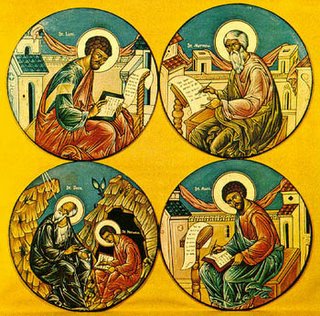
The The Da Vinci Code claims that the New Testament is a forgery and that the Gnostic gospels and the Dead Sea Scrolls are the original Christian texts.
This claim, however, is flatly contradicted by an overwhelming amount of scholarship by Christians and non-Christians. Many scholars believe that the New Testament was written during the first century and that the Gnostic texts were written no sooner than the second century. And, the Dead Sea Scrolls don't contain any gospels of any kind. In fact, the Dead Sea Scrolls do not contain any Christian writings of any kind.
There are four New Testament Gospels, which are named Matthew, Mark, Luke and John. Many scholars believe that these were written during the century in which Jesus lived. The Gnostic gospels are generally believed to have been written later – about 100 to 300 years later. These Gnostic texts borrow some elements from Christianity, including the names of Jesus and his apostles, but these writings are not Christian.
There are major differences between the New Testament Gospels and the Gnostic gospels. The New Testament Gospels contain details about life in the land of Israel during the first century. They also contain several references to Old Testament passages, prophecies and theological concepts. For Christians, the New Testament is the continuation of the Old Testament. In contrast, the Gnostic texts contain very little detail to suggest that their authors had ever been to the land of Israel, or that they were even alive during the first century. And the theological concepts of the Gnostic texts sharply contradict those that are found in the Old Testament.
Consider this from pages 26 and 27 of The Truth Behind the Da Vinci Code, by Richard Abanes:
"But were the Gnostic gospels written prior to the books of Matthew, Mark, Luke and John? Most scholars, Christian and non-Christian, would answer no. They date the Gnostic gospels (for example, those in the Nag Hammadi collection) to about A.D. 150 to 250. Although many of these texts are Coptic translation of earlier Greek texts (that are no longer extant), most scholars agree that the material itself still does not date previous to the mid 100s to the early 200s.
"In other words, the Gnostic texts were written after the books of Matthew (about 65 to 100), Mark (about 40 to 75), Luke (about 60 to 80), and John (about 90). They [the Gnostic texts] were late arrivals, which is one reason why church leaders rejected them. ... These Gnostic gospels not only disagreed with the older [New Testament] Gospels, which were already accepted by Christians, but they lacked authority since their authors were neither a) apostles of Jesus nor b) persons associated with apostles of Jesus. ... No one really knows who wrote the [Gnostic] texts."
As for Brown's claim about the Dead Sea Scrolls - these scrolls were found in 1947, not in the 1950s as Brown mistakenly claims on page 234 of The Da Vinci Code. The Dead Sea Scrolls contain copies and fragments of Old Testament books and various religious and secular writings. But they do not contain any gospels, and they do not contain any references to Jesus. In fact, many of the Dead Sea Scrolls were written centuries before the time of Jesus.
OK...What About the Gospel of Phillip and Jesus Kissing Mary on the Mouth?
The main problem with the "Phillip" passage is that it clearly shows that even in the context of this Gnostic text, Mary Magdalene and Jesus could not have been married. If you read the passage, as shown on page 246 of the hardcopy version of The Da Vinci Code, you'll see for yourself:
"the companion of the Savior is Mary Magdalene. Christ loved her more than all the disciples and used to kiss her often on her mouth. The rest of the disciples were offended by it and expressed disapproval. They said to him, 'Why do you love her more than all of us?'"
If, in the context of this Gnostic text, the Savior and Magdalene were supposedly married, then why would the disciples bother to ask why he loved her more than them?
Can you imagine a scenario in which a group of men would ask a married man, "Why do you love your wife more than us? And, for that matter, why do you keep kissing your wife?" Such a question wouldn't make any sense. In fact, it wouldn't make any sense even if the two were merely engaged or simply dating.
The only way that the question would make sense in the Gnostic text is if there was no reason for Mary Magdalene to be treated any differently than the men. And the only way that this could be true is if Mary Magdalene was supposed to have the exact same relationship with the "Savior" as did the "other disciples." In other words, only if she was not married, or otherwise intimately involved.
There are other problems with Brown's marriage theory:
• Despite Brown's "translation" of that key passage from the Gnostic gospel of Phillip, the word "mouth" doesn't actually appear in the original text. According to page 49 of The Da Vinci Deception, by Erwin W. Lutzer: "You should know that because of the poor quality of the papyrus, a word or two is missing in the original. The text reads, 'Jesus kissed her often on the [blank].' So scholars fill in the blank with the word mouth, face, or forehead, etc. Actually, for all we know the text might have said 'the hand' or even 'the cheek' since the statement implies that he also kissed his other students – presumably on the cheek as is still done in the Middle East."
"the companion of the Savior is Mary Magdalene. Christ loved her more than all the disciples and used to kiss her often on her mouth. The rest of the disciples were offended by it and expressed disapproval. They said to him, 'Why do you love her more than all of us?'"
If, in the context of this Gnostic text, the Savior and Magdalene were supposedly married, then why would the disciples bother to ask why he loved her more than them?
Can you imagine a scenario in which a group of men would ask a married man, "Why do you love your wife more than us? And, for that matter, why do you keep kissing your wife?" Such a question wouldn't make any sense. In fact, it wouldn't make any sense even if the two were merely engaged or simply dating.
The only way that the question would make sense in the Gnostic text is if there was no reason for Mary Magdalene to be treated any differently than the men. And the only way that this could be true is if Mary Magdalene was supposed to have the exact same relationship with the "Savior" as did the "other disciples." In other words, only if she was not married, or otherwise intimately involved.
There are other problems with Brown's marriage theory:
• Despite Brown's "translation" of that key passage from the Gnostic gospel of Phillip, the word "mouth" doesn't actually appear in the original text. According to page 49 of The Da Vinci Deception, by Erwin W. Lutzer: "You should know that because of the poor quality of the papyrus, a word or two is missing in the original. The text reads, 'Jesus kissed her often on the [blank].' So scholars fill in the blank with the word mouth, face, or forehead, etc. Actually, for all we know the text might have said 'the hand' or even 'the cheek' since the statement implies that he also kissed his other students – presumably on the cheek as is still done in the Middle East."
Was Mary Magdalen Married to Jesus?
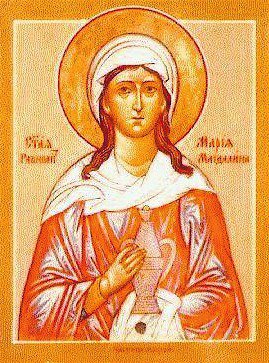
This claim is the backbone of Brown's novel. The The Da Vinci Code claims that Jesus and Mary Magdalene were married, that they had children, and that their descendants included a line of kings in France, as well as some of the main characters in Brown's novel.
Despite Brown's claims, however, there are no historical documents that claim that Jesus was married - not even the "Gnostic gospels" that Brown mentions in his novel. (The Gnostic texts were written a century or more after the New Testament. The Gnostic texts borrow some names and ideas from Christianity but the texts are not Christian and they are not used by Christians.)
The only specific evidence that Brown cites to support this claim of a marriage is a passage from one of the Gnostic texts - the so-called "gospel of Phillip." And that lone piece of evidence actually undermines Brown's claim.
The main problem with the "Phillip" passage is that it clearly shows that even in the context of this Gnostic text, Mary Magdalene and Jesus could not have been married. If you read the passage, as shown on page 246 of the hardcopy version of The Da Vinci Code, you'll see for yourself:
"the companion of the Savior is Mary Magdalene. Christ loved her more than all the disciples and used to kiss her often on her mouth. The rest of the disciples were offended by it and expressed disapproval. They said to him, 'Why do you love her more than all of us?'"
If, in the context of this Gnostic text, the Savior and Magdalene were supposedly married, then why would the disciples bother to ask why he loved her more than them?
Can you imagine a scenario in which a group of men would ask a married man, "Why do you love your wife more than us? And, for that matter, why do you keep kissing your wife?" Such a question wouldn't make any sense. In fact, it wouldn't make any sense even if the two were merely engaged or simply dating.
The only way that the question would make sense in the Gnostic text is if there was no reason for Mary Magdalene to be treated any differently than the men. And the only way that this could be true is if Mary Magdalene was supposed to have the exact same relationship with the "Savior" as did the "other disciples." In other words, only if she was not married, or otherwise intimately involved.
There are other problems with Brown's marriage theory:
• Despite Brown's "translation" of that key passage from the Gnostic gospel of Phillip, the word "mouth" doesn't actually appear in the original text. According to page 49 of The Da Vinci Deception, by Erwin W. Lutzer: "You should know that because of the poor quality of the papyrus, a word or two is missing in the original. The text reads, 'Jesus kissed her often on the [blank].' So scholars fill in the blank with the word mouth, face, or forehead, etc. Actually, for all we know the text might have said 'the hand' or even 'the cheek' since the statement implies that he also kissed his other students – presumably on the cheek as is still done in the Middle East."
• Brown claims that the Aramaic word for "companion" literally meant "spouse." That is not true according to various Aramaic scholars. And, even more importantly, the Gnostic gospel of Phillip was not written in Aramaic. It was written in Coptic.
• None of the Gnostic gospels ever claimed that Jesus and Mary Magdalene were married. Even the so-called Gnostic gospel of Mary Magdalene fails to makes such a claim.
• Finally, consider this from page 41 of The Truth Behind The Da Vinci Code, by Richard Abanes, in regards to the Gnostic Phillip text: Ironically, if this text does anything, it cuts out the very heart of any assertion about Mary and Jesus being wed. It does so by adhering to one of the basic tenets of ancient Gnosticism, which declares that all physical matter was inherently evil. Consequently, sexual relations were intrinsically debasing! The Gospel of Phillip goes so far as to say that marital relations defile a
Friday, February 10, 2006
Were "Lost Gospels" Really Lost?
The Da Vinci Code, Corrected
Why the "lost gospels" were really lost
By Craig Keener
What should we make of the claim in Dan Brown's popular novel The Da Vinci Code that Constantine created the New Testament canon and suppressed 80 "gospels" in favor of the now-established four?
It is true that many works about Jesus (now labeled gospels) circulated both in the first century and later. But Brown's claim is hardly serious history; the vast majority of Christians had been reading precisely our four Gospels as Scripture since the second century at least, as writings from Irenaeus make clear. Church authorities did not wait until Constantine to fish out gospel pretenders.
In fact, the decision to canonize certain gospels rested far more on the dependable teachings handed down from the apostles to bishops than on any imperial fiat. Irenaeus, the first bishop to identify the books of the New Testament, was a disciple of Polycarp, who in turn was a disciple of Ignatius, disciple of the Apostle John. Irenaeus narrowed the canon not according to his own whims or interpretations, but through the "rule of faith" (a loosely formulated confession of faith in the Father, Son, and Holy Spirit and the saving work of Jesus) handed down by the apostolic church.
Further, Matthew, Mark, Luke, and John differ in kind from the second- and third-century works called "gospels," which reflect little or no apostolic tradition and do not even fit the same genre as the canonical Gospels. The four first-century Gospels we possess are, as the church long understood and recent scholarship has confirmed, ancient bioi, or "lives" of Jesus. (A bios focused on the most relevant events of a person's life, commonly leaving gaps in the chronology.) These Gospels include many elements of Jesus' Judean culture, Aramaic figures of speech, and so on; this differs sharply from later stories written about Jesus.
Why the "lost gospels" were really lost
By Craig Keener
What should we make of the claim in Dan Brown's popular novel The Da Vinci Code that Constantine created the New Testament canon and suppressed 80 "gospels" in favor of the now-established four?
It is true that many works about Jesus (now labeled gospels) circulated both in the first century and later. But Brown's claim is hardly serious history; the vast majority of Christians had been reading precisely our four Gospels as Scripture since the second century at least, as writings from Irenaeus make clear. Church authorities did not wait until Constantine to fish out gospel pretenders.
In fact, the decision to canonize certain gospels rested far more on the dependable teachings handed down from the apostles to bishops than on any imperial fiat. Irenaeus, the first bishop to identify the books of the New Testament, was a disciple of Polycarp, who in turn was a disciple of Ignatius, disciple of the Apostle John. Irenaeus narrowed the canon not according to his own whims or interpretations, but through the "rule of faith" (a loosely formulated confession of faith in the Father, Son, and Holy Spirit and the saving work of Jesus) handed down by the apostolic church.
Further, Matthew, Mark, Luke, and John differ in kind from the second- and third-century works called "gospels," which reflect little or no apostolic tradition and do not even fit the same genre as the canonical Gospels. The four first-century Gospels we possess are, as the church long understood and recent scholarship has confirmed, ancient bioi, or "lives" of Jesus. (A bios focused on the most relevant events of a person's life, commonly leaving gaps in the chronology.) These Gospels include many elements of Jesus' Judean culture, Aramaic figures of speech, and so on; this differs sharply from later stories written about Jesus.
The Value of History vs Secret Truth
Here is where we need to consider: what is our faith based upon—revealed truth, or secret hidden truth? My faith is based upon revealed truth, in a written tradition that goes back to Moses (indeed, to Adam—Genesis 5:1). Just before he died, Moses told the Israelites:
‘The secret things belong to the LORD our God; but the things that are revealed belong to us and to our children for ever, that we may do all the words of this law … For this commandment which I command you this day is not too hard for you, neither is it far off. It is not in heaven, that you should say, “Who will go up for us to heaven, and bring it to us, that we may hear it and do it?” Neither is it beyond the sea, that you should say, “Who will go over the sea for us, and bring it to us, that we may hear it and do it?” But the word is very near you; it is in your mouth and in your heart, so that you can do it.’ (Deuteronomy 29:29; 30:11–14).
The reason it was near to them was because God ensured it was written down for them (Exodus 31:18; Deuteronomy 31:9–13, 24–29).
There is no room in Christianity for hidden fundamentals. Hidden depths, certainly, but God has made the fundamentals clear to us in writing so that we are without excuse if we do not heed His Word. According to Jesus, the standard of judgment is the Word He has already spoken to us (John 12:48). It logically follows that God will have provided a reliable record of that word for us, and true history testifies that it is so. But beware of gifted novelists able to use their God-given talents in an attempt to undermine and deny His Word.
‘The secret things belong to the LORD our God; but the things that are revealed belong to us and to our children for ever, that we may do all the words of this law … For this commandment which I command you this day is not too hard for you, neither is it far off. It is not in heaven, that you should say, “Who will go up for us to heaven, and bring it to us, that we may hear it and do it?” Neither is it beyond the sea, that you should say, “Who will go over the sea for us, and bring it to us, that we may hear it and do it?” But the word is very near you; it is in your mouth and in your heart, so that you can do it.’ (Deuteronomy 29:29; 30:11–14).
The reason it was near to them was because God ensured it was written down for them (Exodus 31:18; Deuteronomy 31:9–13, 24–29).
There is no room in Christianity for hidden fundamentals. Hidden depths, certainly, but God has made the fundamentals clear to us in writing so that we are without excuse if we do not heed His Word. According to Jesus, the standard of judgment is the Word He has already spoken to us (John 12:48). It logically follows that God will have provided a reliable record of that word for us, and true history testifies that it is so. But beware of gifted novelists able to use their God-given talents in an attempt to undermine and deny His Word.
False Historical View of Jesus
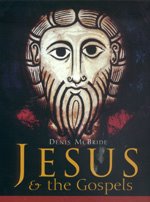
It is misleading to say that Jesus Christ was an ‘historical person of staggering influence whose life was recorded by thousands of followers.’ He was at that time an obscure carpenter who lived and died within walking distance of His birthplace in a backwater of the Roman Empire. His ‘staggering influence’ did not emerge until centuries later, as did the numerous false gospels—after all, there is no point in emulating a nobody. As for Constantine making the choice of Matthew, Mark, Luke and John, the idea is laughable.
Council of Nicaea and Scripture

The gathering of the New Testament documents began within the first century. Paul referred to Luke’s Gospel as ‘scripture’—graphè (1 Tim 5:18 cites both Deut. 25:4 and Luke 10:7 as such). Peter recognized that Paul’s writings were ‘scripture’—in 2 Peter 3:15–17 he refers to them as authoritative and then refers to ‘the other scriptures,’ and he warns his readers to beware of those who twist the meanings to their own destruction.
This process of recognizing the true and separating it from the false gained momentum in the second century when the heretic Marcion produced his own, very reduced, list of authorized books. Since the caricature always comes after the original, this implies that the main features of the NT collection were in place at that time. By the time of the Council of Nicaea in AD 325 (which Constantine convened, but it was the gathering of 318 bishops that made the decisions) the issue was not even debated. The deliberations of the Council focused on the deity of Christ, and the authority of the four gospels on that subject was taken for granted by all the bishops present. The final statements regarding formal recognition of the 27 books of the New Testament that we have today (what we call the Canon) were made at African synods (at Hippo and Carthage) in AD 393 and 397.2
It’s important to note that the Canon was decided by God and merely recognized by man. Leading NT scholar F.F. Bruce put it well:
‘The NT books did not become authoritative for the Church because they were formally included in a canonical list; on the contrary, the Church included them in her canon because she already regarded them as divinely inspired, …. [Church] councils [did] not impose something new upon the Christian communities but codif[ied] what was already the general practice of those communities.’3
One of the world’s greatest authorities on the Greek New Testament, Bruce Metzger, pointed out:
‘You have to understand that the canon was not the result of a series of contests involving church politics. … . You see, the canon is a list of authoritative books more than it is an authoritative list of books. These documents didn't derive their authority from being selected; each one was authoritative before anyone gathered them together.’
Biblical Views: False and True

False Views of the Bible
In the book Sir Leigh Teabing. He says, ‘To fully understand the Grail, we must first understand the Bible … The Bible did not arrive by fax from heaven … [it] is a product of man … not God … and it has evolved through countless translations, additions and revisions. History never had a definitive version of the book. … Jesus Christ was a historical figure of staggering influence … his life was recorded by thousands of followers … more than eighty gospels were considered for the New Testament … Who chose which gospels to include? … The Bible, as we know it today, was collated by the pagan Roman emperor Constantine’ (p.231). The plethora of historical fallacies continues unabated but this one-page sample is sufficient to illustrate the point.
True Views of the Bible
The Bible testifies of itself that it is indeed ‘God-breathed’ (2 Timothy 3:16). Men moved by the Holy Spirit spoke from God (2 Peter 1:21), and Jesus said ‘Heaven and earth will pass away, but my words will not pass away’ (Matthew 24:35; Mark 13:31; Luke 21:33). Neither has its meaning been lost or corrupted through ‘countless translations.’ The original languages were Hebrew (OT, with a few sections in Aramaic) and Greek (NT). Modern English versions, for example, are based on meticulously prepared composites of ancient Greek and Hebrew manuscripts, of which thousands are extant. The Dead Sea Scrolls showed that copies of OT books from the first century BC were almost identical to the previously earliest Hebrew manuscripts from a thousand years later, so copying errors have not been a significant problem.
History certainly has had a ‘definitive version’. The Latin Vulgate remained the definitive version for over a thousand years, and the subsequent divergence between Protestant and Catholic versions was based primarily on theological principles, not manuscript problems. The content of the modern Protestant and Catholic Bibles, except for the few differences in the Old Testament, is all based on similar manuscript evidence. No major doctrine is in any way obscured by manuscript differences. Indeed, the very abundance of similar ancient manuscripts points unerringly to similar original sources.
A Conservative Lashing
The Devil is a liar and the father of lies, and the heart of man is deceitful above all things, and desperately corrupt. Put the two together and you get a very toxic mix indeed.
We must expect, therefore, that the enemies of God will try every strategy possible to discredit the Bible. The latest best-selling book in this mould (claimed on the author’s website to be one of the most widely read books of all time) is The Da Vinci Code, by Dan Brown. The film rights have already been sold to Sony Pictures and a top director has been engaged to produce the film in 2005.
To the casual reader, it is nothing more than good fiction—a murder mystery that pits the keepers of the Holy Grail against Opus Dei—the ‘keepers’ of the Catholic church. So why the outcry? Well, one reason is that the first page makes a bold statement that the novel is based on historical fact—‘all descriptions of artwork, architecture, documents and secret rituals in this novel are accurate’. Nothing could be farther from the truth. The whole work is fiction, and shot full of historical error.
We must expect, therefore, that the enemies of God will try every strategy possible to discredit the Bible. The latest best-selling book in this mould (claimed on the author’s website to be one of the most widely read books of all time) is The Da Vinci Code, by Dan Brown. The film rights have already been sold to Sony Pictures and a top director has been engaged to produce the film in 2005.
To the casual reader, it is nothing more than good fiction—a murder mystery that pits the keepers of the Holy Grail against Opus Dei—the ‘keepers’ of the Catholic church. So why the outcry? Well, one reason is that the first page makes a bold statement that the novel is based on historical fact—‘all descriptions of artwork, architecture, documents and secret rituals in this novel are accurate’. Nothing could be farther from the truth. The whole work is fiction, and shot full of historical error.
A Silly Mistake
Did Pope Clement V Murder Templars?
Possibly Brown’s silliest mistake about the Templars is charging that Pope Clement V not only burnt hundreds of Templars but had their ashes “tossed unceremoniously into the Tiber River”. That the statement is put in the mouth of his “Royal Historian” character, Teabing, only adds to its irony. The largest burnings of Templars actually took place in Paris, with smaller holocausts in three other French cities and possibly Cyprus. There’s no record of Knights burnt at Rome. In any event, the pope couldn’t have dumped any remains in the Tiber since he resided at Avignon in southern France and not in Rome. Also, the Templars had nothing to do with gothic architecture, despite Brown’s claims that they had everything to do with it.
What Does YHWH Really Mean?
Another glaring error is found in character Robert Langdon’s explanation of the origin of the tetragrammaton—YHWH (pronounced as Yahweh)— the sacred name of God, which observant Jews believe should not be uttered. Langdon claims that YHWH comes from the name Jehovah, which he insists is an androgynous union between “the masculine Jah and the pre-Hebraic name for Eve, Havah”. A quick trip to the encyclopedia (or theological dictionary, if you prefer) shows that Langdon is wildly off the mark. The name “Jehovah” didn’t even exist until the thirteenth century at the earliest (and wasn’t common until the sixteenth century), and is an English word. It was created by artificially combining the consonants of YHWH (or JHVH) and the vowels of Adonai (which means “Lord”), the name substituted for YHWH in the Old Testament by Jews. The Hebrew—not “pre-Hebraic”—word for Eve is hawwâ, (pronounced “havah”), which means “mother of all living”. There is absolutely nothing androgynous about any of this, but that dubious assertion is in keeping with the neognostic flavor of the novel.
5 Million Women Burned at the Stake?
More Clear Facts About Muddy Fiction
The Da Vinci Code states that over a three hundred period in the medieval era, the Catholic Church was responsible for burning a total of five million women at the stake. That’s quite a bit off of the best current estimate of 30,000 to 50,000 of men and women killed during the four hundred years from 1400 to 1800—certainly a significant number, but not comparable to the Holocaust or Stalin’s purges. Many of those deaths didn’t involve burning. Witches were hanged, strangled, and beheaded as well. In addition, witch-hunting was not woman-hunting: at least twenty percent of all suspected witches were male. Despite what the novel clams, midwives were not especially targeted; nor were witches liquidated as obstacles to professionalized medicine and mechanistic science.
The Da Vinci Code states that over a three hundred period in the medieval era, the Catholic Church was responsible for burning a total of five million women at the stake. That’s quite a bit off of the best current estimate of 30,000 to 50,000 of men and women killed during the four hundred years from 1400 to 1800—certainly a significant number, but not comparable to the Holocaust or Stalin’s purges. Many of those deaths didn’t involve burning. Witches were hanged, strangled, and beheaded as well. In addition, witch-hunting was not woman-hunting: at least twenty percent of all suspected witches were male. Despite what the novel clams, midwives were not especially targeted; nor were witches liquidated as obstacles to professionalized medicine and mechanistic science.
Opus Dei

One of Brown’s “bizarre true facts” is that Opus Dei exists and “has recently completed construction of a $47 million, 133,000-square-foot American Headquarters at 243 Lexington Avenue in New York City.” Why this is considered bizarre is, well, bizarre. Far more bizarre than the existence of a personal prelature of the Catholic Church - erroneously described as “a church” in the Code - is the character of a murderous albino Opus Dei monk. Never mind that Opus Dei is not a religious order and that it consists of mostly lay people, with less than 2% of its members being priests. As others have noted, Brown’s mythical Opus Dei has simply taken the place of the Jesuits, an order commonly depicted as murderous, vile, and corrupt by anti-Catholics writing in the 1800s and well into the 1900s.
The Divinity of Jesus
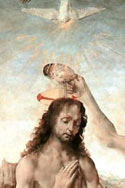
Much attention has been given to The Da Vinci Code’s claim that Jesus was married to Mary Magdalene. But an even more audacious claim of the novel is that the divinity of Jesus was first raised and established at the Council of Nicaea in A.D. 325, and that prior to that time, no one—not even Jesus’ followers—believed Jesus was anything more than a “mortal prophet” and great man. The fact that this has caused hardly a ripple among fans of the novel indicates a revealing (and hardly surprising) lack of knowledge about early Church history and belief.
There is plenty of evidence that the early Christians, dating back to Jesus’ time on earth, believed that Jesus of Nazareth was divine. In his seminal study, Early Christian Doctrines, noted scholar J.N.D. Kelly writes that “the all but universal Christian conviction in the [centuries prior to the Council of Nicaea] had been that Jesus Christ was divine as well as human. The most primitive confession had been ‘Jesus is Lord’ [Rom 10:9; Phil 2:11], and its import had been elaborated and deepened in the apostolic age.”
The Council of Nicaea did not define that Jesus, the Son of God, was divine (since that was accepted by all Christians) but addressed the issue of the exact relationship between the Son and the Father: Are they equal? One in substance? Two Persons? The Council specifically addressed and condemned the popular heresy of that time, called Arianism, which insisted that the Son was a lesser god, created by the Father at some point in time and not eternally exi
The Virgin of the Rocks
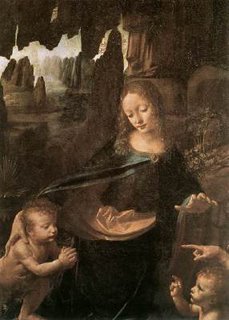
The Virgin of the Rocks
Brown and his main character, symbologist Robert Langdon, state that “the nuns” of the Confraternity of the Immaculate Conception gave Leonardo specific dimensions and themes about a commissioned painting for an altar triptych. But there were no nuns in the Confraternity; it was an all-male group, consisting of either brothers, or lay men, or a combination of both. More importantly, Brown states that “the nuns” had asked for a painting that would include Mary, Jesus, John the Baptist, and the angel Uriel, and he followed that request, but his first painting was filled with “explosive and disturbing details”.
Actually, Leonardo did not follow the Confraternity’s directives as to the subject matter of the painting. The original contract was to include a depiction of God the Father overhead, with two prophets on the side panels (The Virgin of the Rocks was the centerpiece). There has been much scholarly discussion about the exact nature of the contract and what exactly transpired between Leonardo and the Confraternity. What is clear is that Leonardo deviated substantially from the original plan for the subject matter—not that it contained “several disturbing ‘un-Christian’ anomalies”.
The Da Vinci Code correctly notes that there are two versions of this painting—the earlier one is in the Louvre in Paris and the later one is housed at the National Gallery in London. But Brown describes the painting as a “a five-foot-tall canvas”, when it is actually 198 x 123 centimeters, or about 6.5 feet tall (1.99 meters tall x 1.22 meters wide, according the Louvre web site). It was originally painted on wood panel, but was transferred to canvas; the second version of the painting, in London, is still on a wood panel.
In the novel, the main female character, Sophie, picks up the painting and moves it will relative ease; it is described as flexing as she pulls it from the wall. In reality, she likely wouldn’t have been able to move it or pick it up, and it’s doubtful that it would flex. Normally, such artistic license wouldn’t be much of a concern, but Brown insists his details are accurate, claims that he attended art school in Spain, and points out that his wife is an art historian. And yet he is completely wrong about the dimensions of a painting, even though the information can be obtained in a few minutes at the library or on the internet.
Leonardo da Vinci
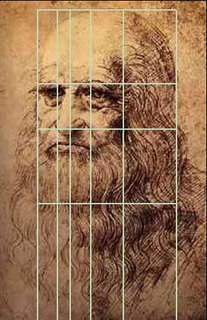
Leonardo da Vinci
On a webpage titled “Bizarre True Facts from The Da Vinci Code . . .”, Brown writes that Leonardo was a “prankster and genius” who is “widely believed to have hidden secret messages within much of his artwork.” Widely believed by whom? It’s difficult to find any reputable art scholar or historian who would agree with that remark. But according to Brown, “most scholars agree that even Da Vinci's most famous pieces—works like The Mona Lisa, The Last Supper, and Madonna of the Rocks—contain startling anomalies that all seem to be whispering the same cryptic message.”
First, no scholar would ever refer to the great Italian artist as “Da Vinci” since his given name was “Leonardo”; “da Vinci” indicates the province he was from. Secondly, few, if any, scholars would concur with Brown’s dramatic assertion. Thirdly, there are no “startling anomalies” in any of the paintings Brown mentions. Any such anomalies can only be found in his novel and conspiracy-heavy books such as The Templar Revelation, which happens to be the source of almost all of Brown’s “research” into Leonardo. As for the cryptic message, which one is Brown referring to? He claims the Mona Lisa is an androgynous self-portrait, insists The Last Supper depicts Mary Magdalene at the right of Jesus, and claims Madonna of the Rocks (better known as The Virgin of the Rocks) depicts John the Baptist scandalously blessing the Christ-Child.
Brown’s site states that this cryptic message “hints at a shocking historical secret which allegedly has been guarded since 1099 by a European secret society known as the Priory of Sion.” Nevermind that the Priory of Sion was founded in the 1950s in France by a political radical, that its mysterious history is an admitted fabrication, and that it has been proven more than once to be a complete hoax. And yet the Priory of Sion is a central element in the plot and logic (so to speak) of The Da Vinci Code.
Fact or Fiction
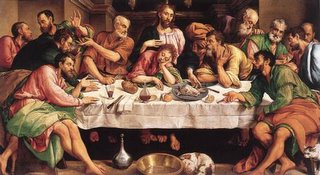
Facts vs. Fiction in The Da Vinci Code
By Carl E. Olson and Sandra Miesel
A frequent question asked by readers of Dan Brown’s The Da Vinci Code is “How much of the novel’s depiction of historical events, people, artwork, and institutions is correct.” The short answer is “Not much.” In fact, the only thing more amazing than Brown’s consistent misrepresentation of facts is a widespread acceptance of his claims, with both reviewers and readers praising the “research” and “knowledge” supposedly evident in his novel. The Da Vinci Hoax: Exposing the Errors in The Da Vinci Code examines, in much detail, the lengthy list of claims made in the Code. Here is a brief look at just a few of the claims made in Brown’s novel and on his web site.
An Opportunity for Witness
George Barna and other Christian evangelicals highlight the cultural opportunity that awaits us. We are standing on the banks of a river and watching our culture drift toward deadly falls. The people in the boat are paddling toward destruction, but we are un-engaged. What do we care about movies? New York Time Bestsellers? What does that have to do with me, especially if I think that stuff is junk?
The attitude that "the world is full of crazed idiots chasing after even crazier ideas" is not the attitude that the Apostle Paul took at the Acropolis in Athens. There, he walked among strange gods, statues to each one, and engaged the people of Athens on their own turf.
Here, in this blog we seek to walk among the gods of madison aveneue and their followers...especially as they seek to revise Christian history and carve new images of Jesus and Mary that blemish the truth.
The attitude that "the world is full of crazed idiots chasing after even crazier ideas" is not the attitude that the Apostle Paul took at the Acropolis in Athens. There, he walked among strange gods, statues to each one, and engaged the people of Athens on their own turf.
Here, in this blog we seek to walk among the gods of madison aveneue and their followers...especially as they seek to revise Christian history and carve new images of Jesus and Mary that blemish the truth.
Subscribe to:
Posts (Atom)
